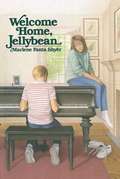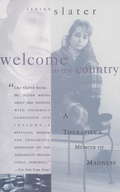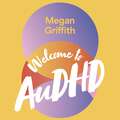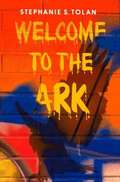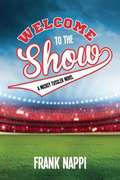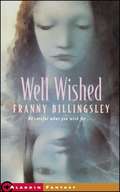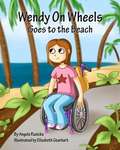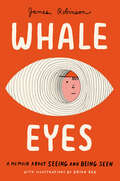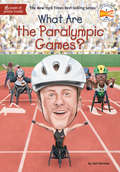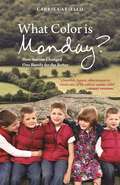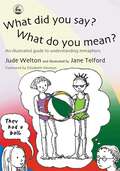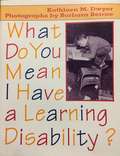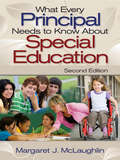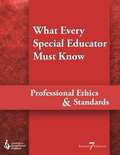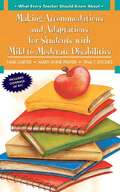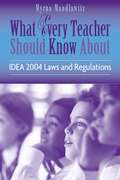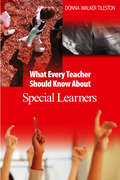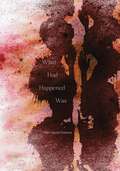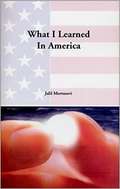- Table View
- List View
Welcome Home, Jellybean
by Marlene Fanta ShyerNeil Oxley's older sister, Geraldine, is coming home for the first time. After spending most of her life in institutions for the retarded, she is finally going to live with her family and adapt to the "real world".
Welcome To My Country
by Lauren SlaterA psychologist's perceptions of mental illness which are illustrated with stories her patients have told her--privacy always protected.
Welcome to AuDHD: How to Survive (and Thrive) as an Adult with Autism and ADHD
by Megan GriffithWhether you just got diagnosed as AuDHD, or came to the realization on your own, you're probably wondering...what do I do now? That's how Megan Griffith felt after her own AuDHD diagnosis in her late 20s. So she wrote the AuDHD welcome guide that she (and so many other late-realized AuDHDers) desperately needed.As an adult who's AuDHD, you need adult advice on how to do adult things, like how to make dinner every single night for the rest of forever, or how to interview for, get, and keep a job without burning out. You need support that's designed for you as an adult, and as someone who's not just autistic, not just ADHD, but both.This book covers all of that, and more. From gentle emotional validation to incredibly practical advice, and exercises to help you create real change in your daily life, Megan Griffith is ready to be your guide into the wonderful, terrible, confusing, liberating world of AuDHD.Welcome home.
Welcome to the Ark
by Stephanie S. TolanFrom the author's web site: In a world of random violence and multiplying militias, four brilliant young misfits are thrown together in a group home for troubled youth. Isolated by their special abilities, Miranda, Doug, Taryn, and Elijah are unable to cope in a society that regards them as freaks. But in the experimental program they dub the Ark, the four discover they are not alone. Slowly, as connections form among them, they discover that their minds have a power they could never have imagined. Drawn together by their deep concern for the future, they embark on a mission to stop the violence that is engulfing the world. The challenge seems impossible.... In this compelling, sensitively written story, Stephanie Tolan paints a disturbing picture of a violence-ridden world. Yet her characters offer a bright ray of hope for anyone who cares about the fate of the earth. The story of the Ark is gripping, suspenseful, heartbreaking, and, ultimately, inspiring.
Welcome to the Show: A Mickey Tussler Novel, Book 3 (Mickey Tussler Series #3)
by Frank NappiIt’s 1950 and Mickey Tussler-the now-famous pitching prodigy with autism and a golden arm-is back for another baseball season in this third installment of Frank Nappi’s critically acclaimed Legend of Mickey Tussler series. Talk of Mickey’s legendary exploits on the field has grown since his improbable debut two years prior, as have the fortunes of Murph and the rest of the lovable ragtag Brew Crew. Now Mickey, Murph, and Lester find themselves heading to Bean Town to play for the Boston Braves.The call up is sweet, for all of them have overcome insurmountable odds to get where they are. But life in the major leagues is filled with fast-paced action both on and off the field. The bright lights of Boston hold a new series of challenges, hardships, and life lessons-especially for Mickey, who finds himself a long way from throwing apples into a barrel back on the farm. The three newest Braves have each other to lean on, as well as a new group of fans who are swept away by pennant fever, but balancing everything this new world has to offer may prove to be the greatest challenge of all.Sky Pony Press, with our Good Books, Racehorse and Arcade imprints, is proud to publish a broad range of books for young readers-picture books for small children, chapter books, books for middle grade readers, and novels for young adults. Our list includes bestsellers for children who love to play Minecraft; stories told with LEGO bricks; books that teach lessons about tolerance, patience, and the environment, and much more. While not every title we publish becomes a New York Times bestseller or a national bestseller, we are committed to books on subjects that are sometimes overlooked and to authors whose work might not otherwise find a home.
Well Wished
by Franny Billingsley"A coin for passage to your heart's desire," says Agnes, Guardian of the Wishing Well in the village of Bishop Mayne. "That is the first rule." But Nuria doesn't think she needs a wish. Wishing on the Well is dangerous. Wishes often go wrong. That's why there are no other children around. A wish-gone-wrong took them all away. But now, because her grandfather, the Avy, has wished for them to come back, Nuria is sure that the one thing she wants -- a friend her own age -- will soon be there. "One wish each lifetime," says Agnes. "One cycle of the moon to repent and call it back. That is the second rule." Only a fool would make a wish that needs to be called back, Nuria thinks. But that's before she meets Catty Winter, who cannot walk, whose legs are mysteriously crippled. "Make a wish for me," Catty pleads. And Nuria is tempted. But what if the wish goes wrong? "And for that cycle of the moon your lips are locked in this: To no one may you speak of your wish. To no one but to me, for your wish is my wish too. That is the third rule." Nuria has given little thought to the third rule. But there come moments when she wishes it did not exist. The Wishing Well, she is trickier than anyone has known. The Wishing Well in Bishop Mayne has a mind of its own and creates problems for all who try to use its power. Few have gotten anything but misery from it. Knowing this, however, does not keep Nuria, in a time of dire need, from trying to accomplish what few others have managed. Beauty and greed, warmth and cold, walk hand in hand in this unusual fantasy to create an adventure filled with friendship, challenge, and the magic of love.
Wendy on Wheels Goes to the Beach
by Angela M. RuzickaWendy on Wheels is a ten-year-old girl who rolls through life while using a wheelchair. She enjoys her life without limitations and inspires us to live our lives to the fullest regardless of circumstances. Wendy on Wheels Goes to the Beach follows an exciting day at the beach with Wendy, Mom and Dad.
Westray: My Journey from Darkness to Light
by Vernon TheriaultVernon Theriault was off shift when the Westray mine exploded in 1992, killing twenty-six men in Plymouth, Nova Scotia. Theriault took part in the perilous rescue operation that followed, as the small community hoped against hope that survivors would be found. As the magnitude of Westray took hold, Theriault found himself struggling with post-traumatic stress disorder and nightmares. When he tried to re-educate himself for another line of work, he discovered that he was both illiterate and dyslexic. Theriault found new purpose when he became part of a labour movement that successfully lobbied the federal government to bring in a worker-safety law that became known as the Westray Bill. Theriault collaborated with his cousin Marjorie Coady to write this book, which contains colour photographs as well as excerpts from the report of a judicial inquiry that called Westray “an accident waiting to happen.” Theriault describes what it was like to work underground in the mine and takes readers through the harrowing rescue, which recovered fifteen of the twenty-six bodies. Theriault openly discusses his complicated journey in this straightforward, simply written memoir, which begins with the promise of a good job with good pay at Westray.
Whale Eyes: A Memoir About Seeing and Being Seen
by James Robinson"This lively, interactive...heartfelt memoir is truly eye-opening and will encourage readers to seek out his other works."—Booklist, starred review An accessible and immersive account of growing up with strabismus, a condition of eye misalignment...Robinson presents a sincere reflection on childhood experiences of growing up in a world not built with him in mind."—Publishers Weekly, starred reviewFrom Emmy Award–winning documentary filmmaker James Robinson comes a breathtaking illustrated memoir for middle-grade readers (and adults, too)—inspired by the viral, Emmy-nominated short film Whale Eyes.Told through an experimental mix of intimate anecdotes and interactive visuals, this book immerses readers in James&’s point of view, allowing them to see the world through his disabling eye conditions.Readers will get lost as they chase words. They&’ll stare into this book while taking a vision test. They&’ll hold it upside down as they practice &“pretend-reading&”…and they&’ll follow an unlikely trail toward discovering the power of words. With poignant illustrations by Eisner Award–nominated artist Brian Rea, James&’s story equips readers of all ages with the tools to confront their discomfort with disability and turn confused, blank stares into powerful connections.
What Are the Paralympic Games? (What Was?)
by Gail Herman Who HQIt's time to cheer for the inspiring athletes of the Paralympic Games! As the Opening Ceremony for the 1948 Summer Olympic Games commenced in London, a similar sporting competition was taking place a few miles away. But the men at Stoke Mandeville weren't your typical athletes. They were paralyzed World War II veterans. The games at Stoke Mandeville were so successful that they would eventually lead evolve into the Paralympics. Participants from all around the world vie for the gold medal in a variety of sports, including archery, basketball, swimming, speed skating, and ice hockey. Author Gail Herman highlights their achievements, describes how these athletes train--both mentally and physically--for the games, and gives the reader a better understanding of what makes the Paralympic Games one of the world's most viewed sporting events.
What Blind People Wish Sighted People Knew About Blindness! (Revised Edition)
by Harry Martin<P>Harry Martin became blind as the result of an eye disease he contracted while serving in the Navy in 1973. His eye condition began as a case of severe visual impairment, and progressed to total blindness over a period of twenty years. Harry lives with his wife, Carol, and his guide dog, Frankie in Orlando, Florida. <P>THIS BOOK IS A MUST READ FOR ALL SIGHTED PEOPLE! <P>Whether you know a blind person or not, you must read this book. The reader will gain a new understanding of what it is like to be blind, and to go blind. Find out why some blind people can see. Learn how guide dogs work. Discover how blind people do things without sight. If you have a blind relative, friend, spouse, or co-worker; this fascinating book will tell you how to relate to them better. Teachers, this book is an outstanding educational tool. Use it to teach your students all about blindness and the blind.
What Color is Monday?: How Autism Changed One Family for the Better
by Carrie Cariello"One day Jack asked me, 'What color do you see for Monday?' 'What?' I said distractedly. 'Do you see days as colors?" Raising five children would be challenge enough for most parents, but when one of them has been diagnosed with Autism Spectrum Disorder, life becomes a bit more chaotic, a lot more emotional, and full of fascinating glimpses into a unique child's different way of thinking. In this moving memoir, Carrie Cariello invites us to take a peek into exactly what it takes to get through each day juggling the needs of her whole family. Through hilarious mishaps, honest insights, and heartfelt letters addressed to her children, she shows us the beauty and wonder of raising a child who views the world through a different lens, and how ultimately autism changed her family for the better.
What Color is the Sun
by Kenneth JerniganA Kernel Book, this has life stories from 14 blind people.
What Did You Say? What Do You Mean?: An Illustrated Guide to Understanding Metaphors
by Jude Welton Jane TelfordChildren with autism or Asperger Syndrome (AS) have difficulty understanding figurative language because they use and comprehend language literally and expect words to mean exactly what they say. This can often lead to misunderstandings at home and in the classroom. Jude Welton looks at a hundred of the most common figures of speech in this visual workbook designed as a springboard for family and classroom discussions. Each figure of speech is accompanied by an illustration showing its literal meaning, which will help AS children recognize and learn to enjoy metaphors and figurative language. The book can be used by parents one-to-one with their ASD child. Teachers can also use the book as the basis for classroom work on figurative language.
What Disability Service Providers Should Know About Psychiatric Disabilities
by Ed FiloThis book examines the legal implications in accommodating students with psychiatric disabilities in college. Case law, OCR letters, and other applications are discussed.
What Do You Mean I Have a Learning Disability?
by Kathleen M. DwyerTen-year-old Jimmy just accepts the fact that other kids can do things better than he can. It's always been that way--but now Jimmy is starting to think there must be a reason. One day he whispers to his cat, "I'm so stupid. I know I am." This true story has a happy ending. One of Jimmy's teachers encouraged his parents to have Jimmy tested, and it turned out that he had a learning disability. Hard work and perseverance, and the support of his family, helped Jimmy overcome his disability. For children who are learning disabled, and for their families and friends, this inspiring book offers encouragement and support in a shared effort.
What Every Principal Needs to Know About Special Education
by Margaret J. MclaughlinLead effective special education programs that promote student achievement! Updated to address recent federal mandates, this new edition of the best-selling guide helps principals navigate accountability requirements and build high-quality special education programs. New information enables educational administrators to: Address requirements of NCLB and the 2004 reauthorization of IDEA, including standards-based individualized education programs Ensure that special education students can appropriately access the general curriculum Understand standardized testing options and accommodations to comply with federal law Support accurate identification and eligibility decisions, including Response to Intervention procedures Promote positive behavior and encourage family involvement
What Every Special Educator Must Know: Ethics, Standards, and Guidelines for Special Education (5th edition)
by Council for Exceptional ChildrenWhat Every Special Educator Must Know contains the latest 2002 CEC performance-based standards for all beginning special educators. A valuable resource for teacher preparation programs seeking CEC/NCATE accreditation and students and teachers striving to acquire state licensure, this brief book includes: CEC Code of Ethics, The Professional Practice Standards, and Mentoring Standards.
What Every Special Educator Must Know: Professional Ethics and Standards
by Council for Exceptional ChildrenCEC wrote the book on special education ... literally. CEC s famous red book details the ethics, standards, and guidelines for special education preparation and practice. Delineating both knowledge and skill sets and individual content standards, What Every Special Educator Must Know is an invaluable resource for special education administrators, institutional faculty developing curriculum, state policy makers evaluating licensure requirements, and special educators planning their professional growth.
What Every Teacher Should Know About Adaptations and Accommodations for Students with Mild to Moderate Disabilities
by Nari Carter Mary Anne Prater Tina T. DychesThis book serves as a guide and resource for general education teachers who teach students with mild to moderate disabilities. The book describes some difficulties students with disabilities experience in school and provides evidence-based teaching suggestions. Many of these suggestions may also benefit students without disabilities, as teachers differentiate instruction to meet the needs of all learners in the classroom.
What Every Teacher Should Know About IDEA 2004 Laws and Regulations
by Myrna MandlawitzA timely, jargon-free guide to the IDEA 2004 "laws and regs!" This handy booklet provides everything teachers and administrators should know about IDEA 2004 and its practical implications. It includes concise descriptions of the statutes, with a side-by-side comparison of the "old" regulations versus those just issued by the DOE in August 2006. A critical "top-drawer" reference for every educator! This clear, comprehensive, jargon-free resource outlines IDEA 2004 and its regulations and highlights their practical implications for practicing and pre-service teachers and administrators. The booklet provides concise descriptions of the aspects of the IDEA law every classroom teacher should know, with a side-by-side comparison of the "old" regulations versus those just issued in August 2006. When a little friendly background would help the reader better understand the practical implications of the regulations, an additional note is provided.
What Every Teacher Should Know About Special Learners
by Donna E. TilestonThis resource will help you differentiate content for special learners by identifying special programs and the laws and regulations that govern those programs.
What Had Happened Was
by Therí Alyce PickensIn her debut poetry collection, What Had Happened Was, Therí Alyce Pickens investigates the complex structures of Black storytelling. Addressing topics ranging from Black life, popular culture, and history to individual encounters with emotion, love, and chronic disability, Pickens crafts and questions the stories we tell ourselves about who we are and who we want to be. Throughout, Pickens mines the formal structures and the play of Black English within the lives and afterlives of Harriet Tubman, Mary J. Blige, Lil' Kim, Breonna Taylor, and figments of our collective imagination. Her singular poetic voice effortlessly flows between what she knows and what she’s heard and between everyday Black conversation and her work in cultural criticism and disability studies. Traveling at the speed of thought, Pickens explores a praxis of storytelling governed by the places where truths and fables kiss.
What I Learned in America
by Jalil MortazaviAMERICA, THE LAND OF OPPORTUNITY EVEN FOR A BLIND JOURNALIST FROM IRAN Throughout the world, millions of people believe if you are blind that this prevents you from traveling too far from home. Others, of course, may have these same beliefs but have just kept them to themselves. Thus begins Jalil Mortazavi's engaging and baffling experience as he tries to overcome such odd thinking. In his book, he tries to cover much of what he has learned in the hope that it will inspire, delight, and amuse his audience. Mortazavi is an Iranian-American journalist who lives in Brookline, Massachusetts. He works for the Persian-American Media Watch. He has also been associated with Persian Voice of Boston, 24-Hour Persian Radio based in California, and 24-Hour Persian TV [NI TV]. He has appeared on Imus in the Morning, and he has done some news commentary on National Public Radio's All Things Considered and on Talk of the Nation. In addition, Jalil enjoyed being a guest on a number of different television and radio talk shows WCV TV, American Radio Network in Baltimore, and radio stations WBZ, WHDH, WRKO, WROR, and WTTP. Mortazavi has also written for such publications as The Boston Globe, The Boston Herald, and The Brockton Enterprise.
